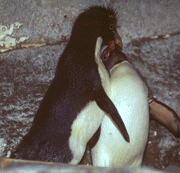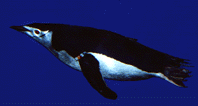
Open the door to the Penguin and Seabird House and you're greeted with a cacophony of calls, amplified for visitors' benefit.
Three species of penguin that make their home in the 18,000 gallon pool live in a completely controlled environment with air temperature rigorously maintained at 35-40 degrees and water at 40 degrees. These flightless social birds live only in the Southern Hemisphere in large colonies in the wild, sometimes as many as several thousand penguins making a home together.
![]()
 Look at their beaks to tell these birds apart. Razorbills
(top) have a vertical stripe across their wide bills. Murre's (middle) beaks
are long and pointed and puffins sport triangular beaks, brightly colored
in summer.
Look at their beaks to tell these birds apart. Razorbills
(top) have a vertical stripe across their wide bills. Murre's (middle) beaks
are long and pointed and puffins sport triangular beaks, brightly colored
in summer.
![]()
![]()
|
![]()
| Turn the corner and you've entered a northern Atlantic coastal environment where common puffins, murres, and razorbills swim in a 10,000 gallon pool and inhabit rocky cliffs that simulate their home in the wild. These birds live only in the Northern Hemishpere. The wave-making machine and overhead spray spray producing drizzle or fog help replicate their native habitat. |
 Rockhopper penguins, named for their quirky looking
method of locomotion, hop from rock to rock in the rugged coastal areas
of their native habitats in South America. Another way to spot rockhoppers
is their distinctive yellow, tasseled head feathers. A penguin's age can
be determined by the length and fullness of these crest feathers.
Rockhopper penguins, named for their quirky looking
method of locomotion, hop from rock to rock in the rugged coastal areas
of their native habitats in South America. Another way to spot rockhoppers
is their distinctive yellow, tasseled head feathers. A penguin's age can
be determined by the length and fullness of these crest feathers. Chinstrap penguins are easily identifiable by
the distinctive stripe under their chin. These birds are reputed to be among
the boldest of all penguins, and they are the only Antarctic species of
penguin at Lincoln Park.
Chinstrap penguins are easily identifiable by
the distinctive stripe under their chin. These birds are reputed to be among
the boldest of all penguins, and they are the only Antarctic species of
penguin at Lincoln Park. King penguins, with their long narrow beaks,
are the largest residents of Lincoln Park's penguin habitat. Unlike most
penguins who incubate two eggs at a time in a rocky nest, king penguins
incubate a single egg on top of their feet, protected by a brood flap.
King penguins, with their long narrow beaks,
are the largest residents of Lincoln Park's penguin habitat. Unlike most
penguins who incubate two eggs at a time in a rocky nest, king penguins
incubate a single egg on top of their feet, protected by a brood flap.